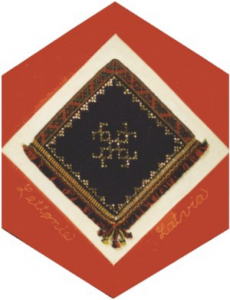Latvia

The Block
Designed and created by Lilija Treimanis and Zinta Enzelins, this block is based on Latvia’s earliest folk costumes, which date back to the 7th century. The woollen fabric was woven from local wool dyed in traditional colours using madder root and woad. Madder root has been used for at least 3000 years for dyeing wool, silk, cotton, paper, wood and leather into orange, purple or yellow, while woad is a perennial herb of the mustard family and is grown as a source of blue dye.
The design reflects the materials and techniques traditionally used in the creation of women’s shawls. Woven fringes and decorative metal rings and spirals, added during the weaving process, embellish the piece. Rings in the centre form the ‘jumis’ symbol, represented by two interlocking stems of wheat. The geometric design, which is repeated in the woven bands of the upper border, is a symbol of fertility and the mystery of life associated with the harvest. A popular element incorporated into jewelry and shawls during the Iron Age, this symbol is often a part of current handcrafts that proudly carry on the folklore and traditions of the past.
Cultural Profile
Latvia (one of the Baltic States, along with Lithuania and Estonia) is located on the eastern shore of the Baltic Sea in north-eastern Europe. Its capital city, Riga, has been an important trading port since the Middle Ages. It is the site of the Dome Cathedral which houses one of the world’s largest and most famous organs. The country is a leader in the area of literacy, with an adult literacy rate of nearly 100 percent. Ethnic Latvians make up more than half the population, and Russians––the largest minority group––represent about one-quarter of the inhabitants. The official language is Latvian, an Indo-European language related to Lithuanian.
Latvian culture is rooted in their native folklore, which has survived for centuries through its rich oral traditions. Poetic verses, legends and ancient dainas, folk songs written in verse form and of which there is said to be 1.2 million, are cultural treasures revolving around the seasons, myths, family life and the land, and tell tales of Latvian life. Dainas are performed during the Latvian Song and Dance Festival, held every five years since 1873 and attended by over 30,000 people. The national epic, Lacplesis (1888; “The Bear Slayer”), is based on Latvia’s rich traditional folklore stories. Love of the theatre and of folk dancing is also a cultural trait of Latvians. Another cultural tradition is the celebration of Jāņi, the summer solstice, when bonfires are lit atop hills and people gather around the fires to sing folk songs.
Latvians are known for their colourful, beautifully embroidered costumes with designs varying from region to region. Belts and sashes, essential elements of the costumes, are made using card-weaving techniques, finger-braiding or loom weaving. The patterns produced are quite varied, though many have been handed down for centuries. The Lielvārde’s belts, from the Vidzeme area, are considered a Latvian symbol. Shrouded in legend, their 22 geometrical patterns in red and white thread are said to represent the origin of the universe. Linen and wool are used extensively in traditional costumes as well as in household items.
The first Latvians, who were mostly farmers, came to Canada as refugees during the 1890s and settled primarily in Manitoba and Alberta. The majority of Latvians arrived later at he end of the Second World War. Though large numbers of the later arrivals held degrees in engineering, medicine, law and other professions, they became involved in agriculture, forestry, and mining in order to fulfill work contracts that were a requirement for their immigration. Once their contracts were completed, many moved to more metropolitan areas where they soon founded firms specializing in such areas as architecture, construction, and printing. Others became prominent in the fields of teaching, medicine, health care, and politics. Latvians contribute immensely to the development of Canadian arts and culture: Maris Vetras founded the Nova Scotia Opera Association; composer Janis Kalnins founded the Fredericton Civic Orchestra, Imant Raminish of British Columbia is a respected conductor of the Vancouver Symphony and the Vancouver Chamber Choir, and pianist Arthur Ozolins is world renown. As of 2011, there were 27,000 Canadians of Latvian ancestry in Canada. Perhaps the most visible demonstration of their culture is the huge one-week festival featuring massed choirs, symphony concerts, recitals, folk dancing, theatre performances and fine art and craft exhibits which is held every two to three years in Toronto.
Sponsor: The Arajs family and the Latvian National Federation in Canada
